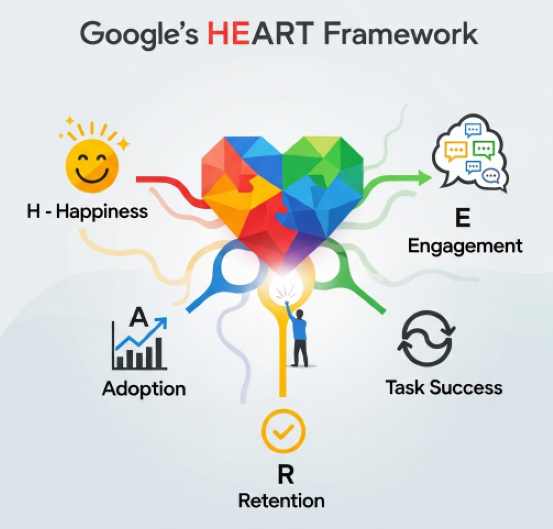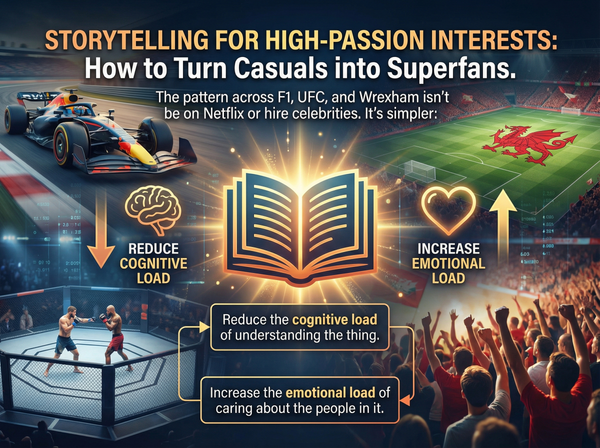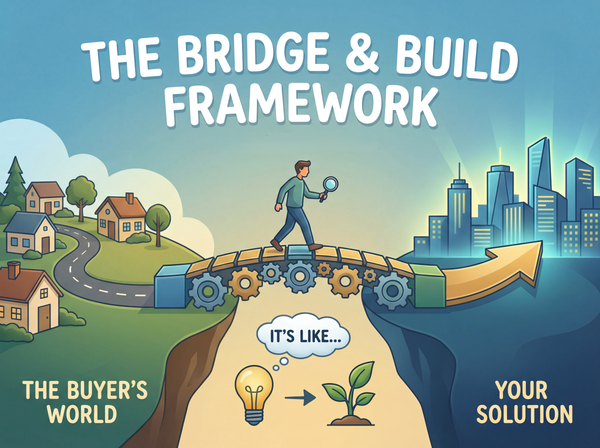Google's HEART Framework: User Experience

It's easy to get caught up in the numbers: clicks, impressions, conversions. While these metrics are important, they often tell only part of the story.
What about the human experience behind those numbers? How truly satisfied are your users? Are they coming back? Are they effortlessly achieving their goals?
This is where Google's HEART Framework comes in. Originally developed for product teams to measure user experience, HEART provides a powerful lens through which marketers can evaluate the true impact of their efforts, shifting focus from mere acquisition to holistic customer success and loyalty.
HEART is an acronym that breaks down into five key user-centered metrics:
H is for Happiness: Are Your Users Truly Delighted?
Happiness relates to how users feel about your brand, content, or product.
Marketing Application:
- Surveys and Feedback: Implement short, targeted surveys on your website, after content consumption, or post-purchase to gauge sentiment. Ask about perceived value, enjoyment, and overall satisfaction.
- Sentiment Analysis: Monitor social media mentions and customer reviews for recurring positive and negative themes.
- Qualitative Feedback: Conduct user interviews or focus groups to understand emotional responses.
Example Metrics: Customer Satisfaction Score (CSAT), Net Promoter Score (NPS), perceived ease of use, aesthetic appeal.
E is for Engagement: Are They Actively Interacting?
Engagement measures the level of user involvement with your product or content over time.
Marketing Application:
- Content Consumption: Track metrics like time spent on page, scroll depth, video completion rates, and repeat visits to blog posts or resource pages.
- Interaction Rates: Monitor comments, shares, likes on social media, form submissions, and downloads of lead magnets.
- Email Marketing: Open rates, click-through rates, and replies indicate engagement with your email campaigns.
Example Metrics: Frequency of visits, duration of sessions, number of key actions per session (e.g., pages viewed, videos watched, comments left).
A is for Adoption: Are New Users Embracing Your Offering?
Adoption focuses on how effectively new users discover, try, and begin to regularly use your product, service, or even new features you introduce.
Marketing Application:
- Onboarding Funnel: For new customers, track completion rates of onboarding steps or initial product setup.
- First-Time Use: Monitor the percentage of new visitors who complete a key initial action (e.g., sign up for a newsletter, make a first purchase, download an app).
- Feature Usage: If you're promoting a new product feature, track how many new users are trying it out.
Example Metrics: Conversion rates from trial to paid, signup rates, percentage of new users completing initial setup, feature activation rates.
R is for Retention: Are They Sticking Around?
Retention is the ultimate indicator of long-term success. It measures the rate at which users continue to engage with your brand or product over time. This is about building loyalty and reducing churn.
Marketing Application:
- Repeat Purchases: Track the number of returning customers and their purchase frequency.
- Subscription Renewals: For subscription-based models, monitor renewal rates.
- Active Users: Define what active means for your business (e.g., logging in weekly, reading a certain number of articles per month) and track the percentage of users who meet this criteria over time.
- Customer Lifetime Value (LTV): A key metric influenced by strong retention.
Example Metrics: Churn rate, repeat purchase rate, subscription renewal rate, active user percentage over various time periods (e.g., monthly, quarterly).
T is for Task Success: Can They Achieve Their Goals Effortlessly?
Task Success measures how effectively and efficiently users can complete specific actions or achieve their objectives using your website, content, or product.
Marketing Application:
- Conversion Funnels: Analyze drop-off points in your conversion funnels (e.g., checkout process, lead generation forms).
- Website Navigation: Are users easily finding the information they need? Track navigation paths and search queries.
- Content Comprehension: Are your educational resources clear and actionable?
- Customer Support Interactions: A high volume of support requests for simple tasks can indicate poor task success.
Example Metrics: Completion rates of key tasks (e.g., completing a purchase, filling out a form, finding specific information), time to complete a task, error rates, number of steps to complete a process.
Why HEART Matters
By integrating the HEART framework into your marketing strategy, you gain:
- A Holistic View of Customer Experience: Move beyond isolated metrics to understand the full customer journey.
- Improved Decision-Making: Pinpoint specific areas for improvement, whether it's content clarity, website usability, or customer service.
- Stronger Customer Relationships: By focusing on user happiness and success, you build trust and loyalty, leading to higher LTV.
- Competitive Advantage: Differentiate your brand by prioritizing genuine customer value over mere transactional exchanges.
- Smarter Resource Allocation: Invest in marketing efforts that truly resonate with your audience and drive long-term positive outcomes.
The HEART framework offers provides a tool to measure what truly matters: the user. By understanding and optimizing for Happiness, Engagement, Adoption, Retention, and Task Success, you can build a marketing strategy that not only attracts customers but keeps them coming back, and transforms them into loyal advocates.
Keep Crushing!
- Sales Guy


